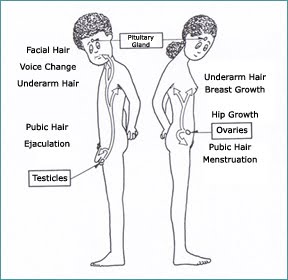Lesson 19: Puberty
Attention

The physical changes of puberty have been with us throughout human history, but it's relationship with the Social Clock, society's expectations for behavior and maturity for people at a particular age, has changed over the centuries.
Learning Outcomes
Upon completion of this lesson's material, students will be able to:
- Identify patterns and risks associated with early and late developing boys and girls
- Review the current literature on adolescent brain development
Teaching
Two types of Changes
- Body changes: including dramatic weight, height, and muscle mass development
- Secondary Sexual Characteristics: maturation of sexual organs, facial and body hair, the development of breasts
Early and Late Maturation
What happens when kids develop either "late" or "early" according to this social clock?
- Boys Early Development
- More positive self-image
- More at risk
- Boys Late Development
- Lower self-esteem
- Girls Early Development
- More emotional problems
- Lower self-image
- Delinquency
- Increased risks related to sexuality
- Girls Late Development
- No significant patterns
The Adolescent Brain
- The brain produces a large number of neural connections prior to puberty
- These diminish through adolescence in the "use it or lose it" pruning process
- The brain becomes leaner and more efficient
- Cells that produce dopamine increase the density of their connections with the prefrontal cortex
- setting priorities
- planning
- forming strategies
- controlling impulses
- focusing attention
- Outer mantal layer increases which correspond with abstract reasoning
- Neurons can "multitask"
Teens need to be surrounded by caring parents, adults, and institutions that help them learn specific skills and appropriate adult behavior.
Review the document below for your own understanding and growth.
The Adolescent Brain: A Work in Progress
The National Campaign to Prevent Teen Pregnancy
Assessment
Possible in-class Discussion
Consider the patterns related to early and late development in boys and girls. Speculate, based on what you know about the social clock in your own culture, why the risk factors (and advantages) of early and late development are present. If you know of a good example of early or late development, relate this story in the discussion.